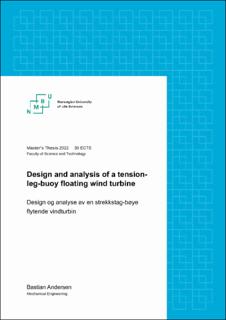| dc.contributor.advisor | Nygaard, Tor Anders | |
| dc.contributor.author | Andersen, Bastian | |
| dc.date.accessioned | 2022-09-21T12:10:47Z | |
| dc.date.available | 2022-09-21T12:10:47Z | |
| dc.date.issued | 2022 | |
| dc.identifier.uri | https://hdl.handle.net/11250/3020222 | |
| dc.description.abstract | In 2016, Anders Myhr published an optimized model of the TLB design,
made significantly more cost efficient than other floating offshore wind turbine
configurations. This model was called the TLB B2 and was designed for a
5MW wind turbine rotor. The desire for larger turbines is high, but technological
readiness regarding anchor loads, has restricted further development of the TLB
B2. As the technology has matured, more robust and rigid anchors now enable
further scaling of the TLB configuration. This thesis revolves around designing
the TLB B2 to fit a 10MW turbine.
The design phase is approached by utilizing the 3DFloat input file created
by Anders Myhr, and scaling the dimensions to fit the mass of a 10MW turbine.
This is done while still preserving core properties from the original design.
3DFloat is used for the entire thesis and is an aero-servo-hydro-elastic Finite-
Element-Method software created by Prof. Tor Anders Nygaard, in order to
simulate offshore wind turbines in a realistic environment.
To prevent resonance, the structure’s natural (Eigen) frequency becomes
crucial. Thus, several Eigen analysis are done throughout the design phase in
order to ensure that none of the Eigen periods interfere with the wave period,
nor the rotational periods of the rotor. To obtain all Eigen modes outside of the
rotational frequencies proved to be rather challenging as the blade- and tower
modes are complexed and hard to manipulate. An Eigen analysis of the final
structure indicates a mode shape with a period equivalent to the blade passing
frequency, making it prone to resonant behavior.
Fatigue was the primary driver for the structure, due to large thrust forces
subjected to the tower. A necessary increase in supplementary tower mass added
to ensure adequate fatigue lifetime, would consequentially increase the floater
mass tremendously due to preliminary constraints defined in the design phase.
The constraints would predominantly protect the floater against buckling, a very
low utilization, confirms that the TLB B2 [10MW] is likely to benefit from
unlocking these constraints.
Despite the large amount of buoyancy, the TLB B2 [10MW] has a relatively
low mass compared to other configurations with a total mass of approximately
3300 tons. However, analysis indicates a great remaining potential in regards of
mass, which can be utilized by further work and optimizations. | en_US |
| dc.description.abstract | I 2016 publiserte Anders Myhr en optimalisert modell av et tidligere TLB design. Denne viste stort økonomisk potensiale sammenlignet med andre flytende vindturbiner. Modellen ble kalt TLB B2 og var designet for en 5MW turbin. Behovet for større turbiner er stort, men manglende kunnskap om forankring har begrenset videre utvikling av TLB B2. Mer modnet teknologi, muliggjør mer robuste ankere oppskalering av TLB konfigurasjonen. Oppgaven sentreres rundt en oppskalering fra 5 til 10MW for TLB B2 designet.
I design fasen utnyttes 3DFloat filen laget av Anders Myhr, og modellen oppskaleres til å passe massen til en 10MW turbin. Dette er gjort uten å endre hovedstrukturen til det originale designet. 3DFloat brukes gjennom hele oppgaven, og er et aero-servo-hydro-elastic Finite-Element-Method program, laget av Prof. Tor Anders Nygaard, med den hensikt å simulere flytende vindturbiner i realistiske omgivelser.
For å unngå resonans, blir strukturens naturlige (Eigen) frekvens sentral, og flere egen analyser er derfor gjort gjennom design fasen. Dette er gjort for å forsikre at ingen av Eigen modene kommer i nærheten av bølge- og rotorfrekvensene. Ettersom blad- og tårn moder er komplekse, og vanskelig å manipulere, indikerer en avsluttende egen analyse mulig resonans ved effektiv rotorhastighet.
For modellen, var utmatting dimensjonerende som følge av store skyvekrefter på tårnet. Tillagt ekstra masse på tårnet sørget for tilstrekkelig levetid, men også stor økning i flytermasse. Dette kom som følge av innledende begrensninger definert i design fasen. Disse begrensningene ble hovedsaklig satt for å beskytte flyteren mot bukling, men en lav utnyttelse bekrefter at TLB B2 [10MW] fordelaktig kan designes uten disse.
Til tross for en høy oppdrift, har TLB B2 [10MW] relativt liten masse sammenlignet med andre konfigurasjoner med en totalvekt på ca. 3300 tonn. Det er likevel et stort gjenværende potensiale med tanke på masse, som kan utnyttes ved vidre arbeid og optimalisering. | en_US |
| dc.language.iso | eng | en_US |
| dc.publisher | Norwegian University of Life Sciences, Ås | en_US |
| dc.rights | Attribution-NonCommercial-NoDerivatives 4.0 Internasjonal | * |
| dc.rights.uri | http://creativecommons.org/licenses/by-nc-nd/4.0/deed.no | * |
| dc.title | Design and analysis of a tension- leg-buoy floating wind turbine | en_US |
| dc.title.alternative | Design og analyse av en strekkstag-bøye flytende vindturbin | en_US |
| dc.type | Master thesis | en_US |
| dc.description.localcode | M-MPP | en_US |

